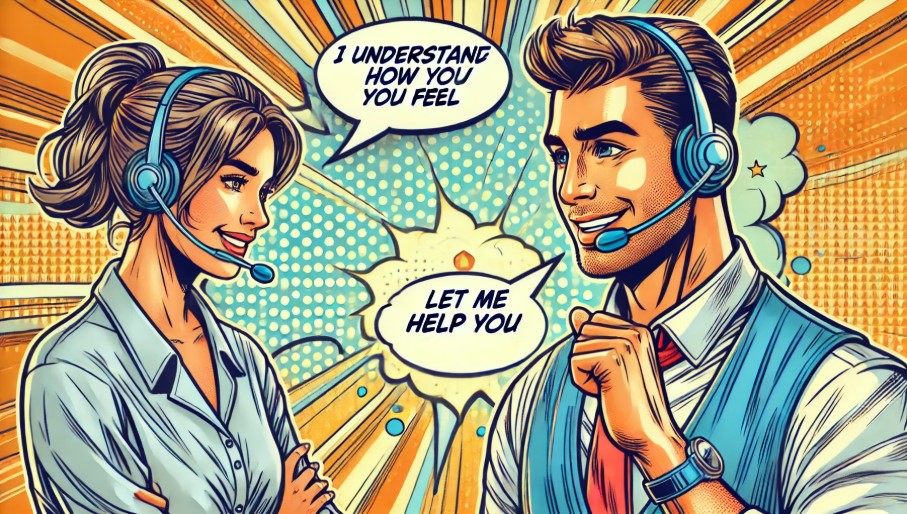Empathy statements take customer service to a new, more personal level. They address and validate customers’ feelings. They help customer support agents stay out of judgment. And they help communicate an emotional response to customers’ inquiries. Empathy creates a unique human connection between the customer and the business. Statements that express empathy serve as vehicles to deliver the message of that connection.

How do you show empathy in customer service?
When it comes to implementing emotional intelligence skills into real-life practice, things can get tricky. Most things are easier said than done. How can agents cultivate and communicate empathy to customers?
Dr. Brene Brown cites four qualities of empathy:
- Recognition of the person’s truth and understanding his/her perspective.
- Staying out of judgment.
- Recognizing the emotion in other people.
- Communicating that recognition.
Thinking of every customer interaction with these four pillars in mind can help take things from theory to practice.
What is an example of an empathy statement?
Of course, different customer service situations call for different empathy statements. Below are some empathy example phrases customer support teams can put into practice.
Communicating Understanding
1. If X happened to me, I would feel Y too
2. I have had a similar experience
3. I appreciate you bringing this to my attention …
4. I realize how complicated it is…
5. I see you’ve been with [Company Name] for X years. That’s a long time.
6. I’m sorry you’ve had to deal with this…
7. That would frustrate me, too.
8. I would be asking the same questions as you are.
9. I would come to the same conclusion.
10. I’m truly sorry to hear about your experience.
11. I understand how frustrating that must have been.
12. I’m sorry you are having this problem.
13. I understand that this has been inconvenient for you and how annoying that must be.
14. I’m sure there is something else you’d rather be doing so thanks for being patient with me.
Reassuring the Customer
15. I appreciate your patience.
16. Thank you for remaining so positive.
17. Your business means a lot to us.
18. I want to thank you for taking the time to speak with me today
19. If I’m understanding you correctly…
20. Let me know if I’m getting the story right…
Dealing with Difficult or Angry Customers
21. I imagine how upsetting it would be…
22. You’re right.
23. What can I do to make your experience with us better?
24. I realize how upsetting this must be for you.
25. You’re absolutely right.
Providing Solutions
26. What would be the best-case scenario for you?
27. Is there anything else, big or small, that I can help you with today?
28. How do you feel about X?
29. Are your X needs being met with our product/service?
30. Moving forward, we can focus on X to ensure this does not happen again.
How to Sound Sincere When Using Empathy Statements
One important thing to note is that while customer service agents can cultivate empathy, they cannot fake it. The ability to empathize does not come prepackaged in a canned response in a live chat. Similarly, mastering a certification exam, like the Microsoft AZ-900 practice test dumps, requires genuine preparation rather than relying on shortcuts, such as finding practice tests dumps, which can undermine long-term knowledge. And a customer can certainly spot insincerity in an agent’s voice on a phone call. That’s why it’s important to focus agents’ professional training on honesty, politeness, and empathy.
To truly communicate empathy, customer support agents must feel it. Empathy statements in customer service communications must come from the heart. Agents must show genuine concern, genuine interest and apply a caring approach that shows that they are on the customer’s side. Only genuine care can lead to a delightful experience. And that, of course, will ease tense situations and minimize the number of dissatisfied customers.
Here are six tips to sound more sincere in customer communications. (Connected Women)
- Don’t use clichés. “We’re sorry we let the cat out of the bag,” vs. “We apologize for accidentally releasing sensitive information. ”
- Don’t use the word ‘sincere’ unless it adds real meaning. “We hope to do business with you again.” vs. “We sincerely hope to do business with you again.”
- Don’t be too formal. “We appreciate you contacting our customer service department and alerting us to the issue in a speedy manner” vs. “Thank you for letting us know about the issue.”
- Say what you mean without weasel words. “I believe most quality marketing techniques are probably designed to make people feel truly connected,” vs. “I think quality marketing techniques are designed to connect people emotionally.”
- Use correct grammar, spelling, and punctuation. “Were glad you liked the product,” vs. ‘We’re glad you liked the product.”
- Believe what you are saying. “The book’s a good read, or so everyone says,” vs. ‘I can personally vouch that the book is a good read.”
Simply using the empathy statements above is not enough to communicate sincerity. Truly walking in the customer’s shoes and understanding the customer is key. To achieve that understanding, applying listening skills is important. This personal approach will give any company a competitive advantage. Human touch, gratitude, and respect for the customer are key to resolving various situations.
The Art of Listening to Customers

Conclusion
In short, empathy is the best way to show customers that you care, regardless of the communication channel. Empathy may not solve the customer’s issue. However, by showing an understanding of the customer’s feelings, agents can begin the path to a successful resolution.
One of the most common causes of customer frustration comes from agents not listening. Simply waiting for a customer to finish speaking and then offering a prepared response does not count. Listening is an art and a skill. It’s one of the best practices of customer service.
Listen carefully and closely to not just what the customers are saying, but the way they are saying it. Clarify that you fully understand and do this with patience. Customers hate repeating themselves. So make sure you make it clear that you’re asking for clarification.
By analyzing the words that a customer has chosen, we can identify the likely emotion that a customer is feeling. You need to look out for indicator words to show you how a customer is feeling. Pay particular attention to such terms as; frustrated, annoyed, discouraged, cross, angry appalled, irate etc. It helps to be aware of any potential synonyms of these words too.
As we mentioned, it’s also the way that customers say those words or write them. In written communication, look out for lock capitals and a lot of punctuation. Shorter sentences illustrate frustration or annoyance. Longer sentences tend to show that the customer is in a calmer emotional state.
As call center agents go through empathy training, it’s important to communicate why. Empathetic phrases and an empathetic attitude lead to customer satisfaction and loyalty. It minimizes negative customer experiences. Even the most disgruntled and frustrated customer might change his or her tune when empathy enters the picture.
How Empathy Creates Human Connections
Empathy is the ability to understand the feelings of another person. Cultivating this concept builds emotional bridges between customers and support teams. Research shows that higher levels of empathy lead to more helpful behavior. It allows people to respond appropriately to how others are feeling. Empathy assists in creating stronger relationships. It reduces stress and enhances emotional awareness.
Less stress and more emotional awareness in customer support teams create more positive customer interactions. These experiences help customers feel connected to the customer service agents who help them.
And when customers feel connected, they are more likely to become loyal supporters of a brand.
Empathy fuels connection. Sympathy drives disconnection. (Brene Brown)
In order to cultivate empathy effectively, it’s essential to understand the distinction between empathy and sympathy. As mentioned, empathy is feeling with people. Sympathy, on the other hand, is feeling pity for someone’s misfortune. The former brings people on the same emotional level, closer together. The latter involves judgment and places one person above another.
Here is a helpful video that shows the distinction:
One of our biggest tasks in customer service is ensuring customers remain customers for as long as possible. Creating an exceptional customer experience increases the likelihood of that. Communicating with the use of empathy statements and listening skills can help.
As a general rule of thumb, approaching any situation with compassion, kindness, and authenticity is key.




